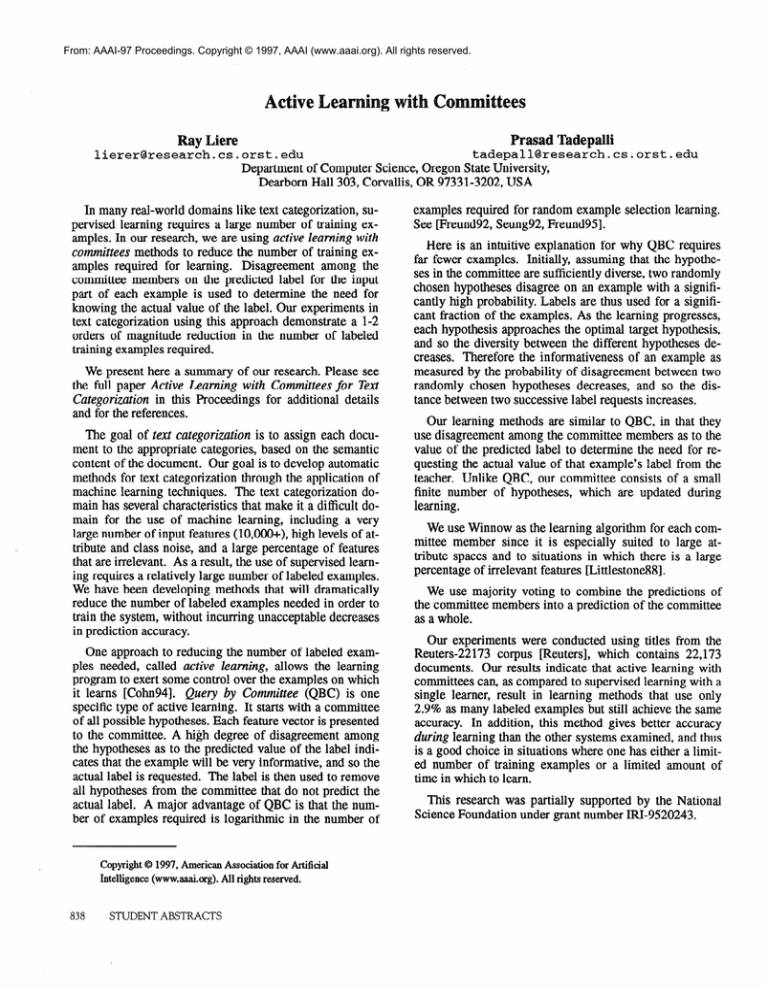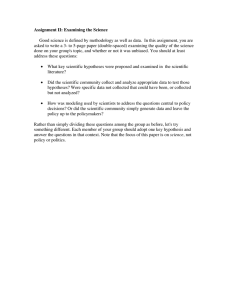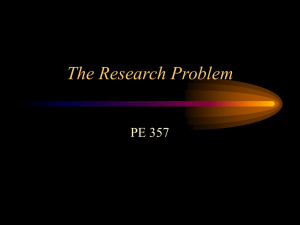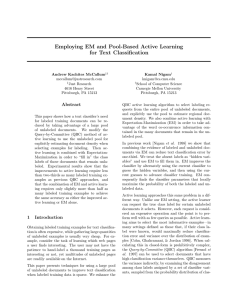
From: AAAI-97 Proceedings. Copyright © 1997, AAAI (www.aaai.org). All rights reserved.
Ray Liere
lierer@research.cs.orst.edu
tadepall@research.cs.orst.edu
Department of Computer Science, Oregon State University,
Dearborn I-Ml 303, Corvallis, QR 97331-3202, USA
In many real-world domains like text categorization, supervised learning requires a large number of training examples. In our research, we are using active learning with
committees methods to reduce the number of training examples required for learning. Disagreement among the
committee members on the predicted label for the input
part of each example is used to determine the need for
knowing the actual value of the label. Qur experiments in
text categorization using this approach demonstrate a l-2
orders of magnitude reduction in the number of labeled
training examples required.
We present here a summary of our research. Please see
the full paper Active Learning with Committeesfor T&t
Categorization in this Proceedings for additional details
and for the references.
The goal of text categorization is to assign each document to the appropriate categories, based on the semantic
content of the document. Our goal is to develop automatic
methods for text categorization through the application of
machine learning techniques. The text categorization domain has several characteristics that make it a difficult domain for the use of machine learning, including a very
large number of input features (lO,OMl+), high levels of attribute and class noise, and a large percentage of features
that are irrelevant. As a result, the use of supervised learning requires a relatively large number of labeled examples.
We have been developing methods that will dramatically
reduce the number of labeled examples needed in order to
train the system, without incurring unacceptable decreases
in prediction accuracy.
One approach to reducing the number of labeled examples needed, called active learning, allows the learning
program to exert some control over the examples on which
it learns [Cohn94]. Query by Committee (QEE) is one
specific type of active learning. It starts with a committee
of all possible hypotheses. Each feature vector is presented
to the committee. A high degree of disagreement among
the hypotheses as to the predicted value of the label indicates that the example will be very informative, and so the
actual label is requested. The label is then used to remove
all hypotheses from the committee that do not predict the
actual label. A major advantage of QBC is that the number of examples required is logarithmic in the number of
Copyright 0 1997, American Association for A,rtificial
Intelligence (www.aaai.org). All rights reserved.
838
STUDENT ABSTRACTS
examples required for random example selection learning.
See preund92, Seung92, Freund951.
IIere is an intuitive explanation for why QBC requires
far fewer examples. Initially, assuming that the hypotheses in the committee are sufficiently diverse, two randomly
chosen hypotheses disagree on an example with a significantly high probability. Labels are thus used for a significant fraction of the examples. As the learning progresses,
each hypothesis approaches the optimal target hypothesis,
and so the diversity between the different hypotheses decreases. Therefore the informativeness of an example as
measured by the probability of disagreement between two
randomly chosen hypotheses decreases, and so the distance between two successive label requests increases.
Our learning methods are similar to QBC, in that they
use disagreement among the committee members as to the
value of the predicted label to determine the need for requesting the actual value of that example’s label from the
teacher. Unlike QBC, our committee consists of a small
finite number of hypotheses, which are updated during
learning.
We use Winnow as the learning algorithm for each committee member since it is especially suited to large attribute spaces and to situations in which there is a large
percentage of irrelevant features @ittlestonegg].
We use majority voting to combine the predictions of
the committee members into a prediction of the committee
as a whole.
Our experiments were conducted using titles from the
Reuters-22173 corpus [Reuters], which contains 22,173
documents. Our results indicate that active learning with
committees can, as compared to supervised learning with a
single learner, result in learning methods that use only
2.9% as many labeled examples but still achieve the same
accuracy. In addition, this method gives better accuracy
during learning than the other systems examined, and thus
is a good choice in situations where one has either a limited number of training examples or a limited amount of
time in which to learn.
This research was partially supported by the National
Science Foundation under grant number IRI-9520243.










